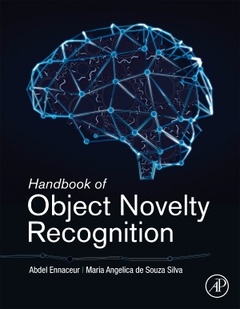Handbook of Object Novelty Recognition Handbook of Behavioral Neuroscience Series

Handbook of Object Novelty Recognition, Volume 26, synthesizes the empirical and theoretical advances in the field of object recognition and memory that have occurred since the development of the spontaneous object recognition task. The book is divided into four sections, covering vision and perception of object features and attributions, definitions of concepts that are associated with object recognition, the influence of brain lesions and drugs on various memory functions and processes, and models of neuropsychiatric disorders based on spontaneous object recognition tasks. A final section covers genetic and developmental studies and gender and hormone studies.
- Object Novelty Recognition Memory
- Theories and Concepts
- Object Novelty Memory Tests: Methods, Test Procedures and Measurements
- The Mouse Visual System and Visual Perception
- Methodological Approaches to the Behavioural Investigation of Visual Perception in Rodents
- Exploiting Novelty and Oddity Exploratory Preferences in Rodents to Study Multisensory Object Memory and Perception
- Variants of the Spontaneous Recognition Procedure Assessing Multisensory Integration Reveal Behavioral Alterations in Rodent Models of Psychiatric and Neurological Disorders
- Visual Object Recognition Task: A Translational Paradigm to Evaluate Sustained Attention Across Species
- Object Novelty and Object Location Recognition Memory in Fish – Recent Advances
- Integration of Human Eye-Tracking Responses and Object Recognition Test Performance
- Developmental Trajectories of Object and Spatial Recognition Memory in Infant Rhesus Macaques
- Perirhinal Cortex Lesions and Spontaneous Object Recognition Memory in Rats: Detecting Novelty But Not Distinguishing Novelty
- Using the Spontaneous Object Recognition Memory Tasks to Uncover the Neural Circuitry of Recognition Memory: The Importance of Thalamic Nuclei
- The Hippocampal-Cortical Networks Subserving Episodic Memory and Its Component Memory Systems for Object, Place and Temporal Order
- The Papez Circuit and Recognition Memory: Contributions of the Medial Diencephalon and Retrosplenial Cortex to What, Where and When Aspects of Object Recognition Memory
- Correlates of Object Exploration and Recognition Memory in Mouse Anterior Cingulate Cortex
- The Amygdala and Emotional Arousal Effects on Object Recognition Memory
- Immediate-Early Gene Expression in Neural Circuits Related to Object Recognition Memory
- Item-Place Encoding Through Hippocampal Long-Term Depression
- The Contribution of Recollection, Familiarity and Discrimination to Object Recognition Deficits in Advanced Age
- The Value of the Object Recognition Paradigm in Investigating Animal Models of Alzheimer's Disease: Advances and Future Directions
- Mild Traumatic Brain Injuries and Object Recognition
- The Use of Object Recognition Task in Animal Models of Attention-Deficit Hyperactivity Disorder
- The Neuropharmacology of What, Where, When: How Dopamine Modulates Recognition Memory for Objects and Their Contexts
- The Role of Cholinergic System in Novel Object Recognition
- Nicotinic Receptor Ligands and Novel Object Recognition
- Novel Object Recognition Test in Rodents: Which Roles for Serotonin Receptors?
- Object Recognition and Object Location Recognition Memory – The Role of Dopamine and Noradrenaline
- Histaminergic Modulation of Recognition Memory
- The Roles of Neurotrophins in Novel Object Recognition
- Cannabinoid Modulation of Object Recognition and Location Memory—A Preclinical Assessment
- Hormonal Regulation of Object Memory Consolidation
- The Role of Sex and Sex Steroids in the Novel Object Recognition Task
- Sex Differences in Cognitive Responses to Stress in Rodents
- Glutamate Signalling in Object Novelty Recognition Memory Tests
- The Role of Ketamine in Object Recognition Memory in Rodents
- Nitrinergic Signalling in Object Novelty Recognition
- Phosphodiesterase Inhibitors in Object Recognition and Object Location Memory Test
- Details the brain structures and the neural circuits that underlie memory of objects, including vision and olfaction
- Provides a thorough description of the object novelty recognition task, variations on the basic task, and methods and techniques to help researchers avoid common pitfalls
- Assists researchers in understanding all aspects of object memory, conducting object novelty recognition tests, and producing reliable, reproducible results
Date de parution : 11-2018
Ouvrage de 600 p.
21.4x27.6 cm
Thèmes de Handbook of Object Novelty Recognition :
Mots-clés :
6-Hydroxydopamine; 9780128120125.11-/- 9780128120125.Extrastriate visual areas; Absence epilepsy; Acetylcholine receptors; Acetylcholine; Acquisition; ADHD; Aetiology; Ageing; Alzheimer's disease; Amyloid pathology; Animal model; Animal models; Anterior cingulate cortex; Anterior thalamic nuclei; Associative recognition memory; Attention; Autism spectrum disorder; Basolateral amygdala; BDNF; Behaviour; Bow-tie maze; cAMP; Cannabinoid treatment; cGMP; Cholinergic basal forebrain; Cholinergic; Cognition; Cognition-enhancing drugs; Consolidation; Controlled cortical impact; Cortex; Cortical and subcortical regions; Cross-modal object recognition; Crossmodal; Dopamine D1 receptors; Dopamine; Emotional arousal; Entorhinal cortex; Episodic memory; Episodic-like memory; Error detection; Estradiol; Estrogen; Exploration; Eye tracking; Familiarity; Fluid percussion injury; Freely moving; Genes; Habituation; Hippocampus; Histamine receptors; Histamine; Human; Immediate-early genes; In vivo electrophysiology



